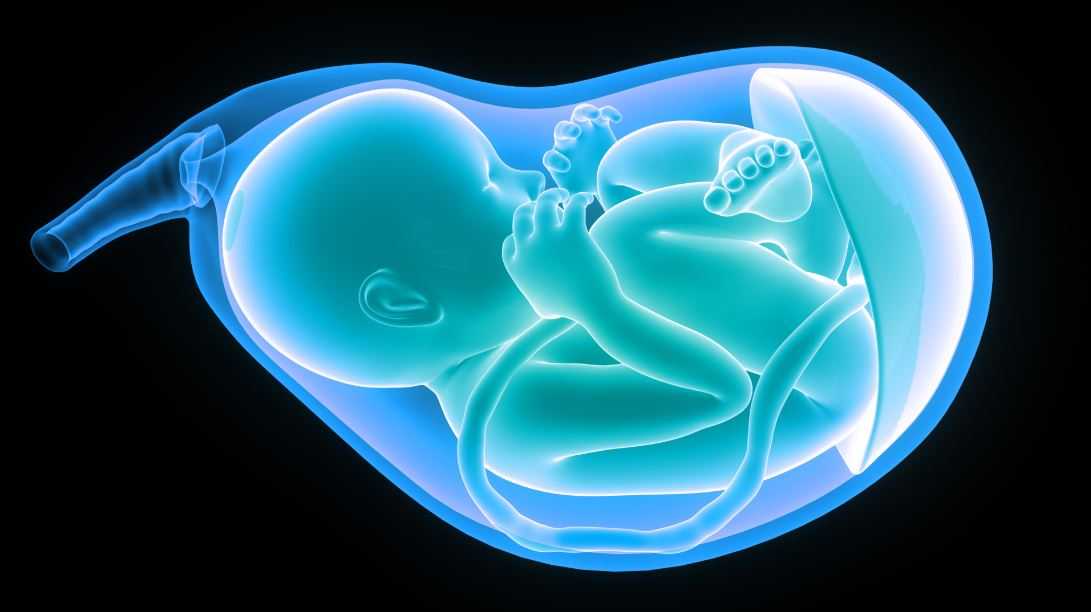A lo largo del cuarto mes de embarazo, el feto termina de formarse y comienza a reaccionar ante estímulos externos como la luz o ciertos ruidos, que percibe a través del vientre de la madre. Su cuerpo está completamente rodeado de lanugo, una capa de fino vello del que se desprenderá a lo largo del embarazo, y su corazón late al doble de velocidad que el de la embarazada.
La bolsa de líquido amniótico mantiene al feto protegido de los golpes y le permite moverse con libertad, girar la cabeza y estirarse. Ya se han formado las cejas y la nariz, y el pelo de la cabeza se hace más grueso.
Los labios, que hasta ahora estaban unidos a las encías, se separan de éstas.
Las piernas son mucho más largas que los brazos. El número de células nerviosas es el mismo que el que tienen los adultos.
Hacia la semana 16 embrionaria el bebé es capaz ya de oír los ruidos que provienen del organismo de la madre. También empieza a percibir la luz a través de las membranas de los ojos, que aún permanecen sellados, y reacciona ante ella cuando se ilumina el vientre materno.
Las huellas dactilares se forman en este mes y empieza a tener sensibilidad en el cuerpo. Comienza a realizar sus primeros gestos como fruncir el ceño y bostezar.
Es posible ver su corazón a través de una ecografía y comprobar que late dos veces más rápido que el de la madre.
Se distingue también, a partir de este mes, el aparato genital del feto. Si es niña, son visibles el clítoris y la vulva, mientras que si es niño puede verse el pene y el escroto.
Seguro que tú y tu pareja ya habéis resuelto vuestras dudas sobre si es niño o niña ¿Ya sabéis cómo le vais a llamar? Te ayudamos a elegir su nombre con nuestro buscador de nombres de bebés.
El bebé puede beber líquido amniótico y orinar.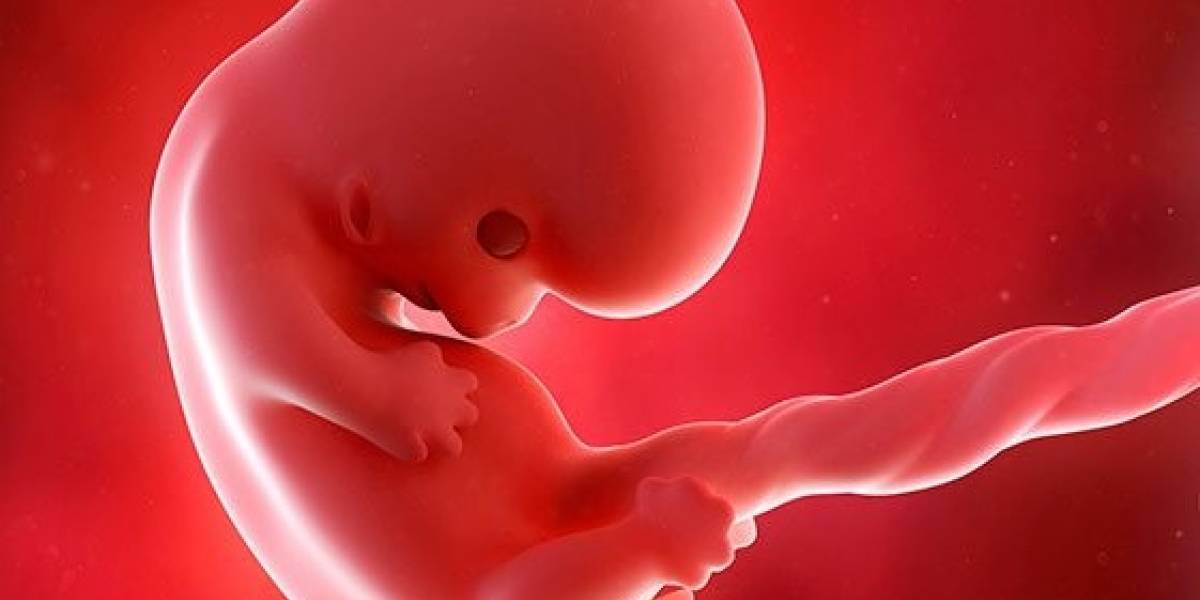 Su intestino se llena de una sustancia verdosa formada por desechos llamada meconio que será lo primero que expulse tras su nacimiento.
Su intestino se llena de una sustancia verdosa formada por desechos llamada meconio que será lo primero que expulse tras su nacimiento.
Su cuerpo está rodeado completamente de lanugo. Al feto, ahora, sólo le queda crecer.
La placenta, adherida a la pared uterina, sigue creciendo y al final de este mes mide un centímetro de espesor.
En el cuarto mes de embarazo tu bebé empieza a tener contacto con el exterior. Si presionas el abdomen con un dedo, quizás notes cómo se mueve.
Tabla de contenidos
En la semana 15 del embarazo el feto puede desplazarse en el líquido amniótico, movimientos que sirven para el desarrollo de su musculatura y que probablemente hagan sentir a la madre ligeros movimientos dentro del vientre. Los cambios físicos son ya evidentes y puede ser el momento de comenzar a utilizar ropa premamá.
Saber más…
En la semana 16 de embarazo la madré comenzará a sentir los movimientos del bebé ya que este empezará a mover sus extremidades dentro del útero.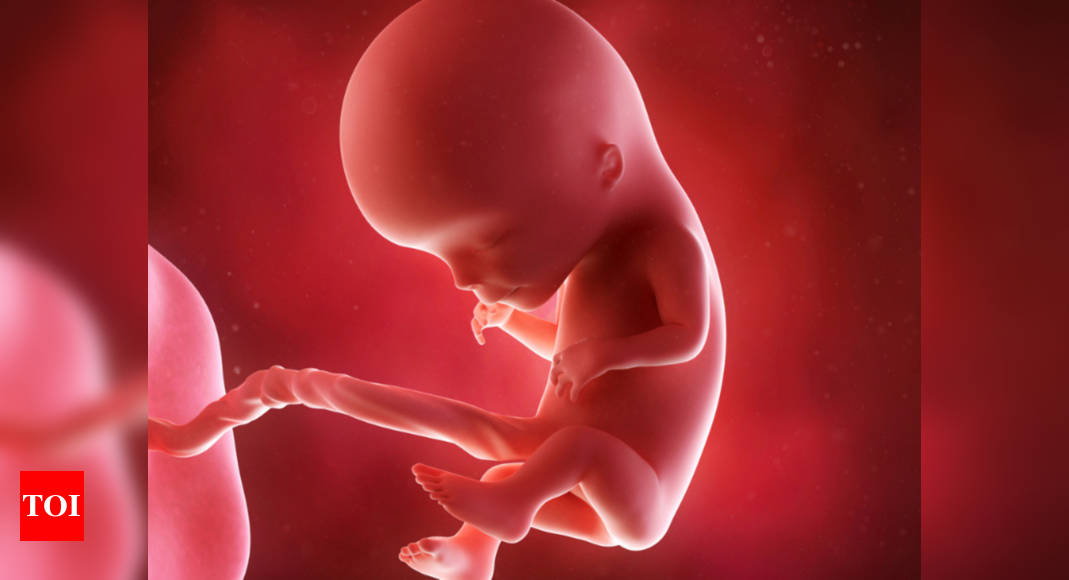 Sin embargo esta sensación puede ser más dificil de identificar en embarazadas primerizas.
Sin embargo esta sensación puede ser más dificil de identificar en embarazadas primerizas.
Saber más…
Durante la semana 17 de embarazo la futura mamá comienza a prepararse para la producción de leche y los cambios físicos de la embarazada son cada vez más evidentes.
Saber más…
En la semana 18 de embarazo, el bebé ya ha desarrollado lo suficiente los genitales para que puedan distinguirse en una ecografía, y puede conocerse ya el sexo del futuro recién nacido. Además será capaz de oír algunos sonidos como los latidos de su corazón o los de su madre.
Saber más…
|
¿Quieres saber más curiosidades? Suscríbete gratis a nuestros boletines y recibirás información personalizada sobre el desarrollo del feto , los cambios que experimentas en el embarazo y cómo vive el embarazo tu pareja. |
Cargando…
Ya han terminado los tres primeros meses de embarazo y con ellos, los momentos más delicados de la gestación. Estás entrando en el cuarto mes de embarazo, es decir, en el segundo trimestre de embarazo, una etapa en la que muchas embarazadas se sienten menos cansadas y somnolientas, con más energía y sin las molestias clásicas de las primeras semanas, ni la incomodidad de las últmas.
Ver también: el desarrollo del bebé semana a semana
En este vídeo del desarrollo del bebé en el cuarto mes de embarazo, te explicamos los principales cambios y desarrollos que sufre tu hijo dentro del vientre materno.
– En esta etapa, tu bebé ya no es un embrión, ahora es considerado en términos médicos como un feto.
– En este período el bebé crece alrededor de 6 centímetros al mes, por lo tanto, al final del cuarto mes de gestación el feto ya medirá alrededor de 14 centímetros y pesará 210 gramos.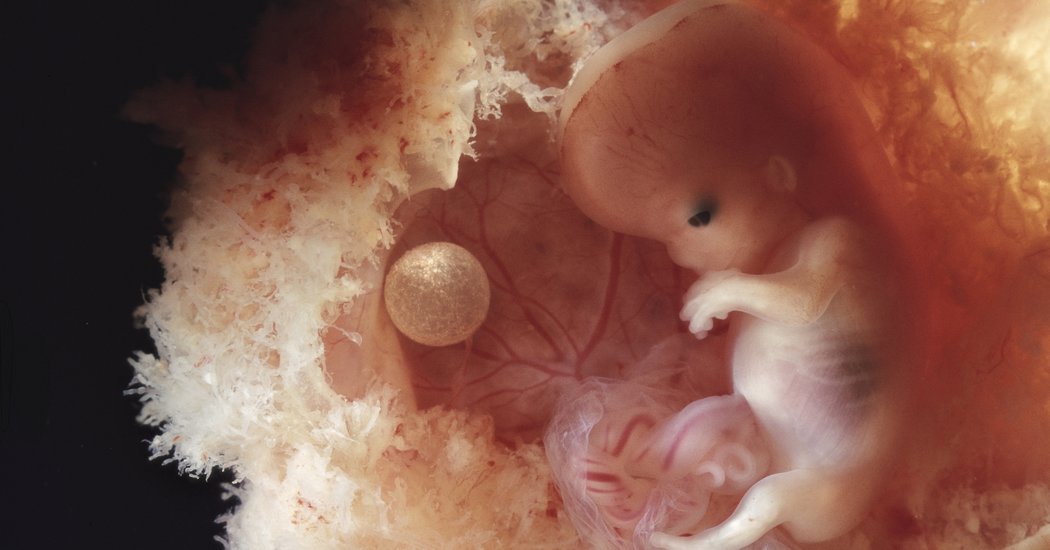
– A través de una ecografía se puede ver perfectamente sus extremidades y en ocasiones en esta etapa del embarazo ya se puede saber el sexo del bebé.
– El bebé en el cuarto mes de embarazo es capaz de girar sobre sí mismo, chuparse el dedo y abrir la boca para tragar líquido amniótico.
– Sus ojos ya están un poco más juntos, lo que le da una apariencia de bebé más humano, ya que en las primeras fases de la concepción tienen una apariencia más similar a la de un pez o un pollo.
– Su sistema nervioso central está extendiendo sus conexiones a todas las partes de su pequeño cuerpo.
– La glándula tiroidea del bebé ha madurado y sus órganos reproductivos han acelerado su desarrollo; está comenzando a producir hormonas por sí mismo.
– La placenta trabaja a pleno rendimiento para aportar la alimentación y el oxigeno que el bebe necesita ahora que se están produciendo tantos cambios y tan deprisa.
– La cabeza ya no es tan grande en relación con todo su cuerpo. Las orejas del bebé casi han llegado a su posición final, aunque todavía se encuentran un poco bajas en la cabeza.
– Los sistemas más complejos (el sistema urinario y el sistema circulatorio) ya funcionan. Tu bebé realiza algunos movimientos precursores de la respiración con el tórax.
relacionados
Un vídeo en el que podrás ver el desarrollo del embarazo y el feto en el tercer mes de embarazo. Imágenes del feto en tercer mes de embarazo. Primer trimestre de…
Un vídeo con que los padres podrán visualizar el desarrollo del embarazo en su primer mes. Imágenes del embrión en el primer mes de gestación.
Un vídeo con que los padres podrán visualizar el desarrollo del embarazo en su primer mes. Imágenes del embrión en el primer mes de gestación.
Imágenes del embrión en el primer mes de gestación.
Un vídeo con informaciones sobre el desarrollo y crecimiento del bebé en el noveno mes de embarazo. Cuánto pesa, cómo se posiciona y cómo está formado un bebé en…
El embarazo semana a semana. Cambios en el cuerpo de la embarazada y desarrollo del bebé en la semana 26 de gestación. Dieta en el embarazo, salud prenatal y…
From the 13th week, the second trimester of pregnancy begins. It is believed that this is the most pleasant and safe period for mother and future baby. But even he requires certain rules to be observed…
With the increase in body weight and the growth of the tummy, the expectant mother may find that the underwear that she wore before no longer suits her.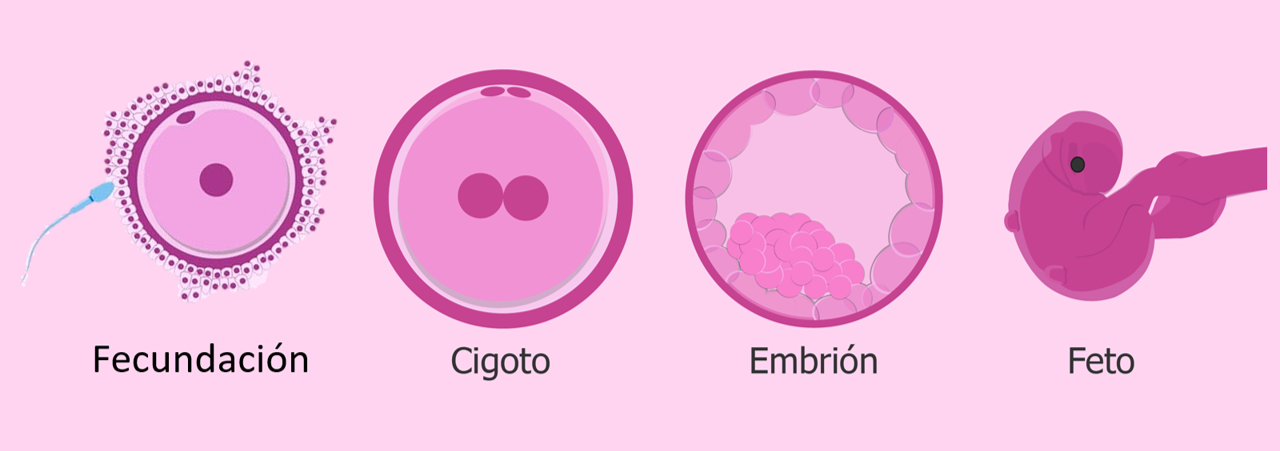 What you need to pay attention to, and how to choose new underwear? This is not such a simple process as it seems to many mothers…
What you need to pay attention to, and how to choose new underwear? This is not such a simple process as it seems to many mothers…
From the 13th week, the second trimester of pregnancy begins, which includes the 4th, 5th and 6th months of pregnancy. It is believed that this is the most pleasant and safe period for mom and baby. Nausea subsides, well-being improves, cheerfulness and activity appear. But even in this period there are worries and peculiarities.
– By the 13th week, my nausea and other discomfort disappeared.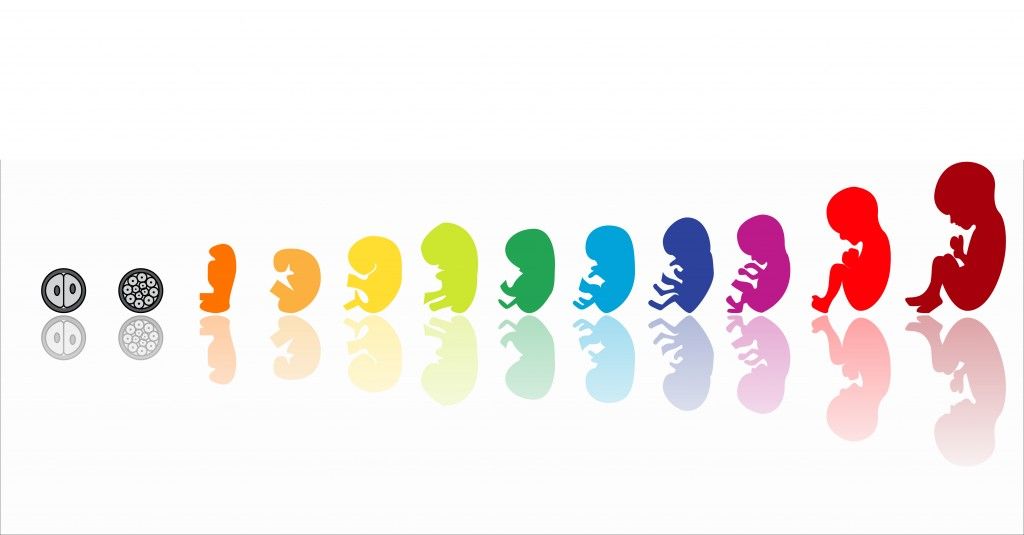 This is fine?
This is fine?
– This is normal, because by the 13th week, the level of progesterone, the main culprit of all discomfort, decreases. Nausea practically disappears, appetite improves.
– Tell me, what other changes can I expect in the 2nd trimester of pregnancy?
– From the 13th week, the uterus begins to actively increase. From the 14th week, you can feel it yourself. It has a rounded shape, its bottom is just below the womb. The uterus grows at the expense of the fetus and amniotic fluid. From the 16th week, the tummy in pregnant women is already noticeable, but so far it does not restrict movement.
– What other tests and examinations do I need to undergo in the 4th month of pregnancy?
– Complete urinalysis, a clinical blood test that will allow you to see the risk of anemia, exclude inflammatory disorders, disorders in the endocrine system.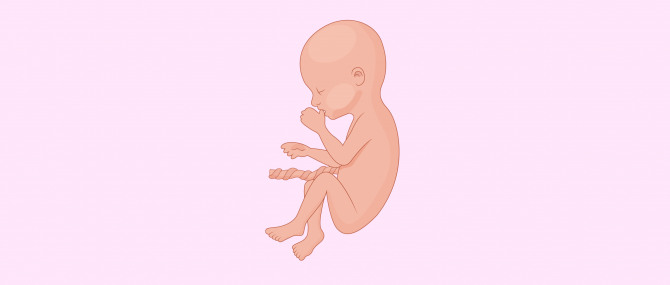 And the most important study is perinatal screening in the second trimester of pregnancy – a triple or quadruple test.
And the most important study is perinatal screening in the second trimester of pregnancy – a triple or quadruple test.
– Why is it called triple or quadruple? Why is this test needed?
– Prenatal screening helps to detect fetal chromosomal pathologies, in particular, Down’s syndrome and eliminate the risk of pregnancy gestosis. Perinatal screening is a combination of ultrasound findings at week 12 and blood tests in the first and second trimesters. In the first trimester, blood is donated for hCG and PAPP-A. In the second – b-hCG, AFP and free estriol (“triple test”), as an option, there is also a fourth indicator – inhibin A.
– I have a negative Rh factor. In the first trimester, I already donated blood for antibodies, when do I need to repeat the analysis?
– This test should be done every fourth week. If the result is negative, then on the 28th week, antiviral immunoglobulin is administered – prevention of the Rh conflict.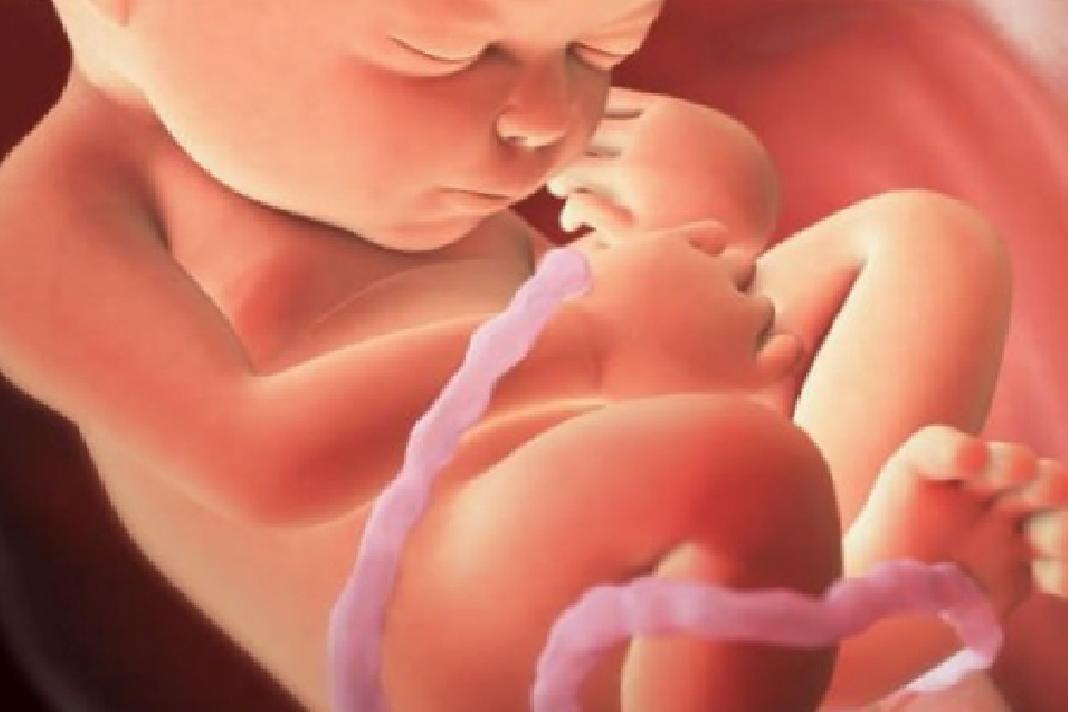 The second dose of the drug is administered after childbirth.
The second dose of the drug is administered after childbirth.
– Does the size of the pelvis matter for childbirth?
– Of course, the size of the pelvis is of great importance. The pelvis is measured with a special instrument – a pelvis. The distance between the most distant points is measured. If the pelvis is very narrow, then it is called anatomically narrow, and childbirth is possible only with the help of a caesarean section. Also, the pelvis is measured on an already mature pregnancy or during childbirth. If a discrepancy between the fetus and the size of the pelvis is detected, then the diagnosis is made: “clinically narrow pelvis”, and the birth is also completed promptly, with the help of a caesarean section.
– If a genital infection is detected on smears, when should it be treated?
– Immunity decreases during pregnancy, which increases the risk of sexual infections.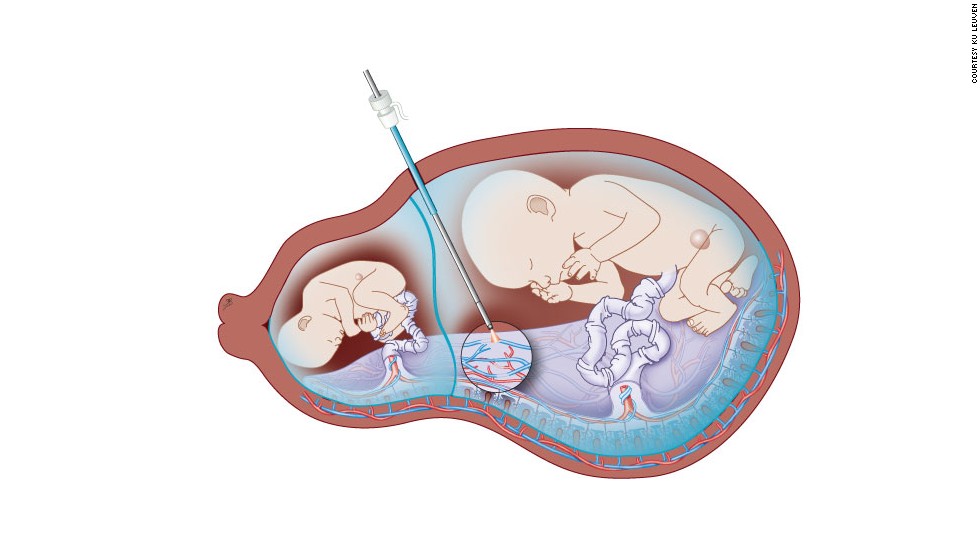 Usually smears are given for PCR diagnosis of genital infections – this allows you to identify the presence of a sexual infection. Additional tests are a bacterial culture from the vagina and a culture to identify the causative agents of a particular infection. If any infection is detected, then in the second trimester, somewhere in the 20th week, a full course of therapeutic treatment can be carried out. Antibacterial drugs are used, including antibiotics, vitamins, immunomodulators.
Usually smears are given for PCR diagnosis of genital infections – this allows you to identify the presence of a sexual infection. Additional tests are a bacterial culture from the vagina and a culture to identify the causative agents of a particular infection. If any infection is detected, then in the second trimester, somewhere in the 20th week, a full course of therapeutic treatment can be carried out. Antibacterial drugs are used, including antibiotics, vitamins, immunomodulators.
– What threatens an untreated infection, how can it harm my baby?
– Untreated infections can cause colpitis, inflammation of the uterus, and cervix. And provoke an abortion at any time. Damage to the internal organs of the fetus can also occur: liver, lungs, brain.
– What is thrush during pregnancy, what are its symptoms?
– Thrush is caused by the yeast-like fungus Candida. The manifestation of the disease depends on the form of the course.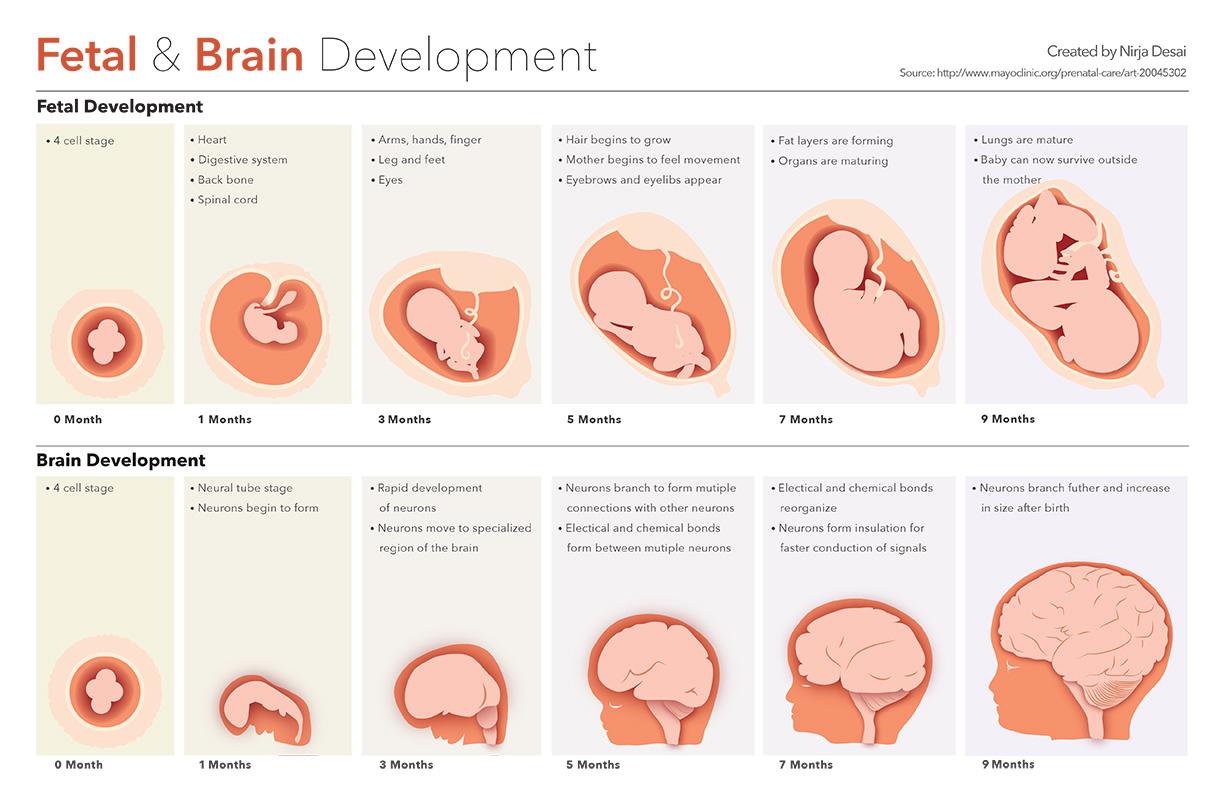 In the acute form: itching, burning in the vagina, swelling, redness of the mucous membranes of the genital organs and abundant curd discharge. In the subacute form, these symptoms may be mild and not particularly disturbing. In carriers of thrush, signs of thrush are detected only with the help of tests.
In the acute form: itching, burning in the vagina, swelling, redness of the mucous membranes of the genital organs and abundant curd discharge. In the subacute form, these symptoms may be mild and not particularly disturbing. In carriers of thrush, signs of thrush are detected only with the help of tests.
– Is the treatment of thrush different during pregnancy?
– Treatment is divided into 2 groups: systemic and local preparations. Systemic: capsules, tablets – they are highly effective, but are contraindicated during pregnancy. During pregnancy, local methods of treatment are used: gels, creams, ointments, suppositories. After 20 weeks, the range of drugs allowed during pregnancy increases. This allows you to quickly cope with the disease.
– How does the baby develop?
– At the 4th month of pregnancy, the organs continue to develop, the brain system becomes more complex, the kidneys and the endocrine system begin to work more actively. Bones grow more actively. By the end of the fourth month, the baby is already 15 cm long. And the weight is 180 grams.
Bones grow more actively. By the end of the fourth month, the baby is already 15 cm long. And the weight is 180 grams.
– What can he do during this period?
– The baby is actively moving. He already carries out reflex movements, extension and flexion of the fingers. Begins to carry out mimic movements, sucks a finger.
– Is it true that at this age there are already rudiments of milk teeth?
– Yes, by the 13th week the fetus has the rudiments of milk teeth.
– And who will I have?
– You are having a boy. By the 16th week, the genitals are already formed. The fetus has grown, and we can already accurately determine its gender.
– With weight gain and belly growth, the expectant mother may find that the underwear she used to wear no longer suits her. “Tell me, please, is it time for me to buy new underwear?”
– Yes, it’s time. Many mothers in the 4th month of pregnancy feel discomfort from their usual clothing size: it presses, and pinches, and irritates the skin. Therefore, 4 months is the time when you need to choose the most comfortable underwear.
Many mothers in the 4th month of pregnancy feel discomfort from their usual clothing size: it presses, and pinches, and irritates the skin. Therefore, 4 months is the time when you need to choose the most comfortable underwear.
– What should I pay attention to? How to choose the right underwear?
– You should always pay attention to your needs. There are a lot of lingerie. Since the figures of expectant mothers are completely different and the demands are also different, then you need to approach the issue of choice, focusing only on yourself. First of all, pay attention to the naturalness of the fabrics. The fabric should be cotton or viscose, with the addition of elastane so that the fabric stretches well. Also, there should be no hard bones in the bra; there are special soft ones – they will not harm. The composition of the soft bones is unique: from the warmth of the body, they stretch and take the shape of the breast. Why should there be no bones? Because already from the first days, milk ducts form in the mother’s breast, and any clamping can harm the formation.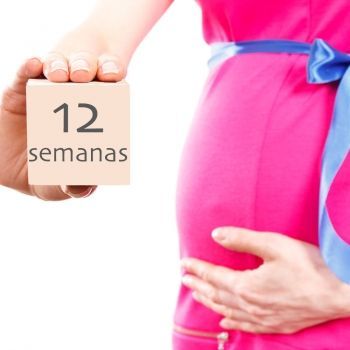 Then there may be problems with lactation. Also, bras are seamless, made of micromodal material. This material is hygroscopic, air freely enters the body through this fabric. In such a bra it is very convenient to play sports, sleep. If you have very sensitive skin, then you can just walk in it every day. The only thing is that such a bra will not give much support to your breasts. The peculiarity of panties for pregnant women is that, firstly, the waist is lowered, so as not to press down on the stomach again, and secondly, the elastic band is weakened. There is also a model with a high waist, this model is suitable for those mothers who have a tummy. Panties should be chosen according to the season: with a high waist it will be hot in summer. Also, according to the growth of your tummy, you select a model, and, of course, the one that you like best.
Then there may be problems with lactation. Also, bras are seamless, made of micromodal material. This material is hygroscopic, air freely enters the body through this fabric. In such a bra it is very convenient to play sports, sleep. If you have very sensitive skin, then you can just walk in it every day. The only thing is that such a bra will not give much support to your breasts. The peculiarity of panties for pregnant women is that, firstly, the waist is lowered, so as not to press down on the stomach again, and secondly, the elastic band is weakened. There is also a model with a high waist, this model is suitable for those mothers who have a tummy. Panties should be chosen according to the season: with a high waist it will be hot in summer. Also, according to the growth of your tummy, you select a model, and, of course, the one that you like best.
– During pregnancy, mothers need to maintain their entire body and teeth are no exception.
– Why should you take care of your teeth during pregnancy? During this period, the hormonal background changes, which affects the condition of the teeth and gums of the expectant mother. Regular dental care is important for both the mother herself and the unborn baby. Any carious cavity, any inflamed gum can cause infection in the body. Many studies show that a disease such as periodontitis can cause premature birth or the birth of a child with low birth weight. Of course, you need to consult a dentist even during pregnancy planning: change old fillings, heal all new holes, and carry out a professional cleaning of the oral cavity. But usually women make an appointment with the dentist when they are already pregnant. It’s not scary. Treating pregnant women’s teeth is not only possible, but necessary.
– Can expectant mothers be given anesthesia?
– Many modern anesthetics are based on artecaine, which is safe for the fetus. Vasoconstrictor substances are not used for anesthesia. Also, by 14-16 weeks, the placenta is finally formed, and through it, anesthesia cannot harm the baby. Therefore, do not endure pain at the dentist, but make high-quality correct anesthesia.
Vasoconstrictor substances are not used for anesthesia. Also, by 14-16 weeks, the placenta is finally formed, and through it, anesthesia cannot harm the baby. Therefore, do not endure pain at the dentist, but make high-quality correct anesthesia.
– At what stage of pregnancy is dental treatment and anesthesia safest?
– The fact is that pregnancy is conditionally divided into three parts. In the first trimester, the baby is laying future organs, in the second trimester – their formation, and in the third – their independent functioning. The most dangerous are the first and third trimesters, the safest is the second.
So, by the end of the 4th lunar month, the baby already looks like an orange. All the systems laid down in the first trimester continue to develop. The baby is already moving, but mommy still does not feel him, because he is still very small.
You are pregnant! Your baby will be born in 40 weeks.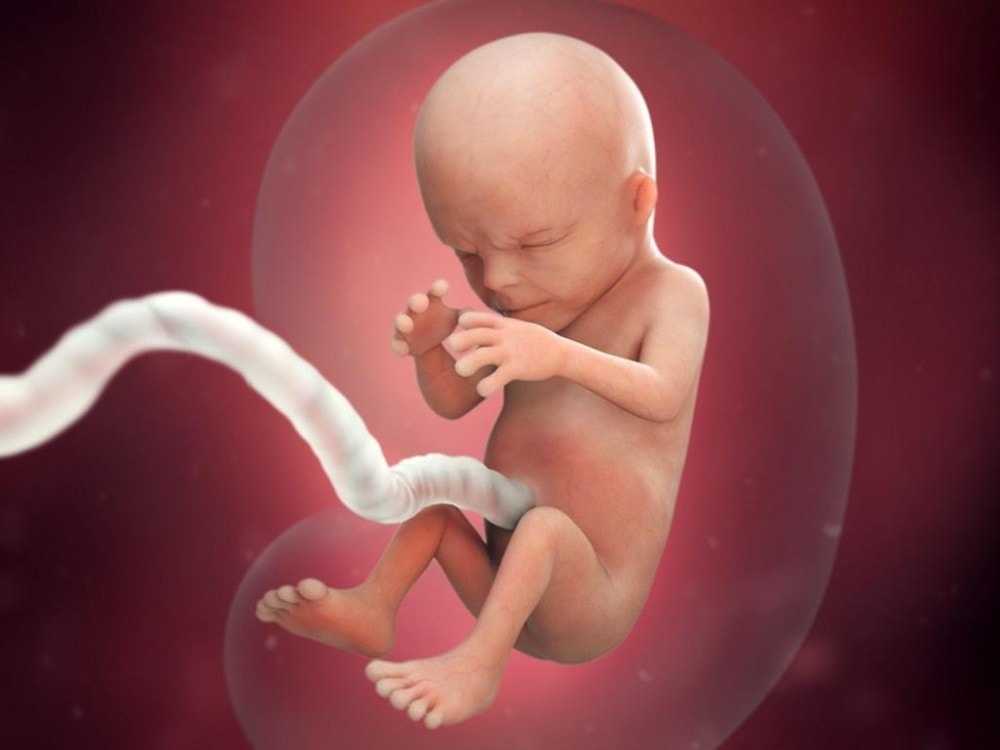 What changes will occur in your body, how your baby will grow will tell “Calendar of pregnancy”.
What changes will occur in your body, how your baby will grow will tell “Calendar of pregnancy”.
Pregnancy begins at the moment of fertilization or conception.
Fertilization is a complex biological process of the fusion of female and male germ cells (egg and sperm). The resulting cell (zygote) is a new daughter organism.
A mature egg leaves the ovary approximately on the 12-14th day of the menstrual cycle (ovulation) and enters the fallopian tube, where it remains viable for 24 hours. During an orgasm, a man ejects from 200 to 400 million spermatozoa into the woman’s vagina. Some of them penetrate through the cervix into the uterine cavity, and from there into the fallopian tubes. Here, spermatozoa retain the ability to fertilize for 48 hours. Thus, within 6-7 days of a woman’s menstrual cycle, conception is possible.
Fertilization of the female egg is performed by a single sperm in the upper part of the fallopian tube.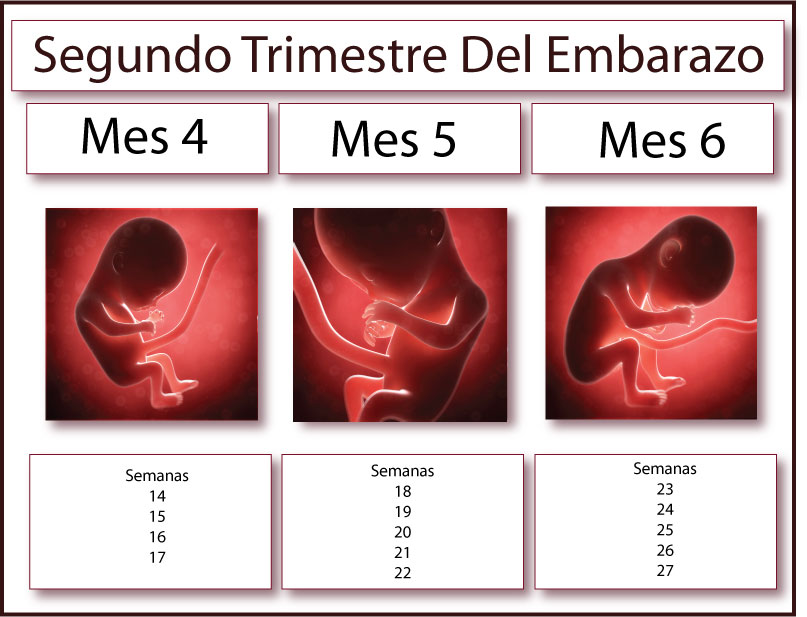 There are two types of sperm: those containing the Y chromosome (“male”) and the X chromosome (“female”). When an egg cell (containing the X chromosome) fuses with a sperm cell, their genetic material is combined and the sex of the child is determined. If there are two X chromosomes in the child’s genetic makeup, it’s a girl; if an X chromosome and a Y chromosome, it’s a boy. It is impossible to change the sex of the child, so you should not follow the “folk beliefs” that guarantee the birth of a child of a given gender.
There are two types of sperm: those containing the Y chromosome (“male”) and the X chromosome (“female”). When an egg cell (containing the X chromosome) fuses with a sperm cell, their genetic material is combined and the sex of the child is determined. If there are two X chromosomes in the child’s genetic makeup, it’s a girl; if an X chromosome and a Y chromosome, it’s a boy. It is impossible to change the sex of the child, so you should not follow the “folk beliefs” that guarantee the birth of a child of a given gender.
The fertilized egg begins to divide with the formation of a multicellular organism and move through the fallopian tube into the uterine cavity. During this period, the nutrition of the embryo is carried out at the expense of those substances that have been accumulated in the egg. If the peristalsis of the tube is slowed down (due to inflammatory diseases), the embryo penetrates the wall of the fallopian tube with the occurrence of an ectopic pregnancy.
Implantation (introduction) of the embryo into the uterine wall occurs 7-8 days after fertilization.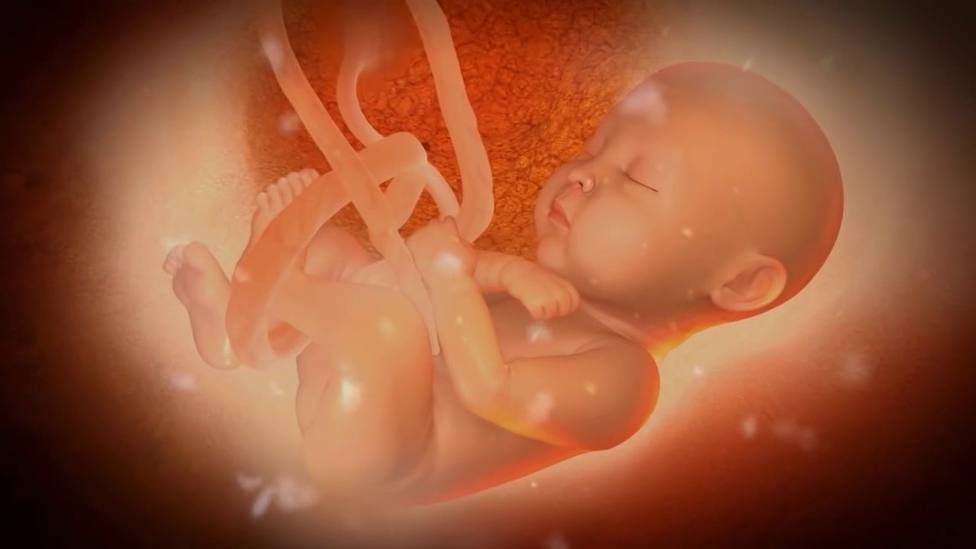
On the seventh day of pregnancy, the outer layer of the embryo (trophoblast) begins to produce a hormone – chorionic gonadotropin. This hormone gives the mother’s body information that pregnancy has occurred, and begins its functional restructuring. Diagnostic test strips detect the chorionic gonadotropin in the urine of a pregnant woman, which makes it possible to diagnose pregnancy at an early stage.
You do not have the expected menstruation, nausea in the morning, and frequent urination during the day. You become emotionally labile, irritable, whiny. Basal body temperature is above 37°C.
In appearance, your unborn baby resembles a small auricle measuring 4 mm, surrounded by a small amount of amniotic fluid. On the 21st day after conception, the brain and spinal cord are formed. By the end of the first month, the circulation of embryonic blood is established, the umbilical cord has formed – the connection of the embryo with the future placenta.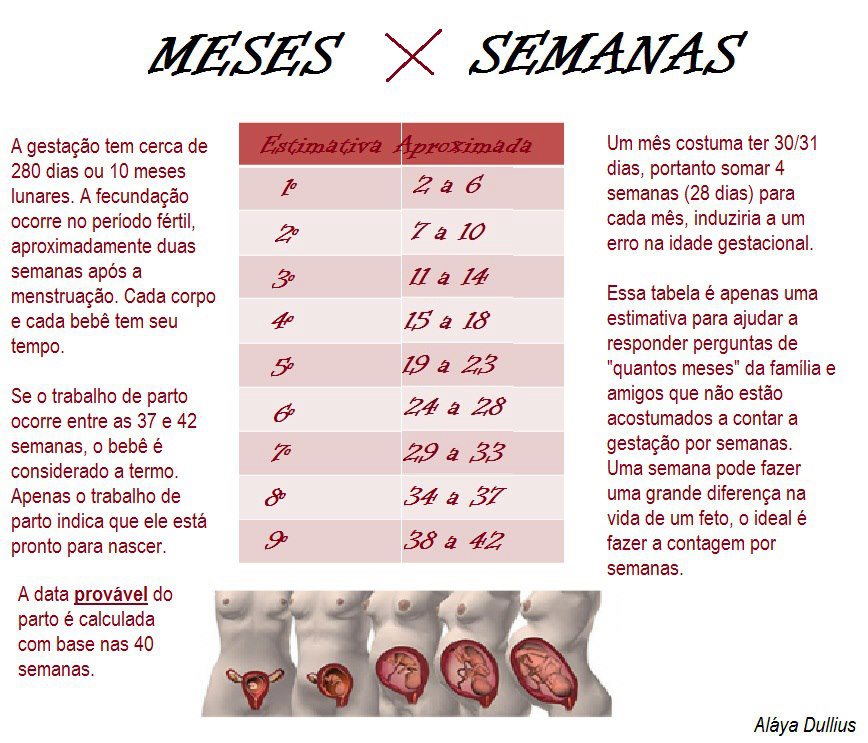 The eye sockets, the rudiments of arms and legs appeared, the laying and development of other internal organs of the fetus is underway: the liver, kidneys, urinary tract, and digestive organs.
The eye sockets, the rudiments of arms and legs appeared, the laying and development of other internal organs of the fetus is underway: the liver, kidneys, urinary tract, and digestive organs.
You no longer doubt that you are pregnant. Regardless of how you feel, all pregnant women need to visit a antenatal clinic and undergo an examination that will allow you to identify and correct existing health problems in time.
Starting from the 5th week, there may be a threat of termination of pregnancy. This will be evidenced by: periodic pain in the lower abdomen and in the lumbar region, a feeling of pressure on the rectum, an increased amount of mucus. If you experience these symptoms, you should consult a doctor.
By week 6, the face is formed in the embryo: eyes, nose, jaws and limbs.
From the 7th week of pregnancy, the yellow body of pregnancy undergoes reverse development, the production of hormones begins to be carried out by the forming placenta.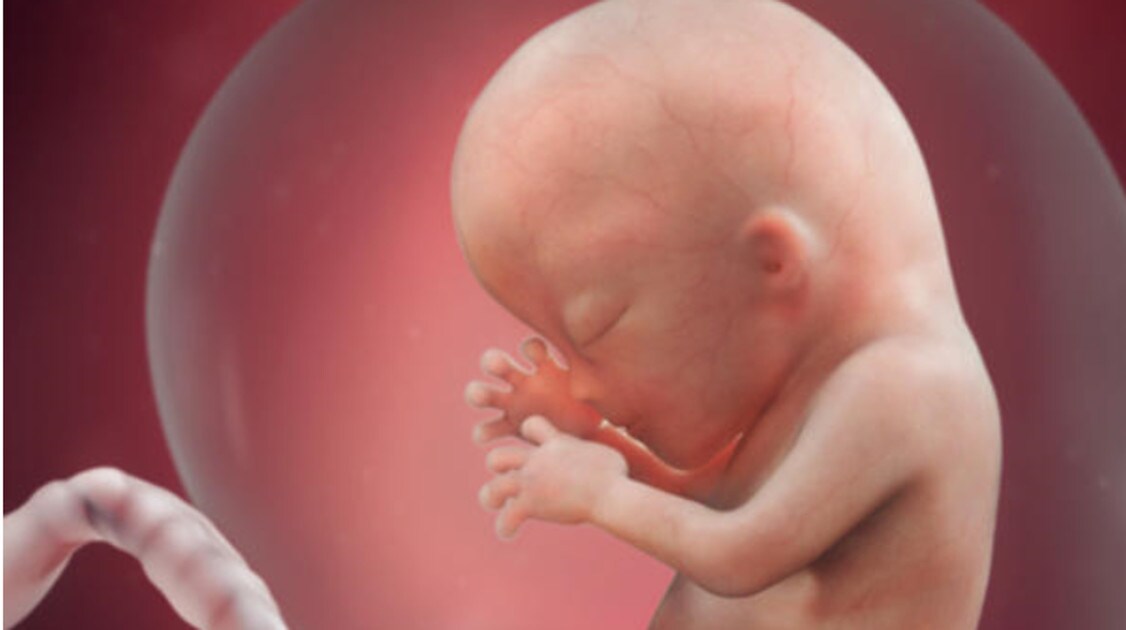
The baby develops large blood vessels, the heart becomes four-chambered. Bile ducts appear in the liver. There is a development of the endocrine glands, the brain. The auricles are already formed, fingers have appeared on the limbs. The embryo begins to move. At week 8, under the influence of the Y chromosome, the formation of male gonads (testicles) occurs. They begin to produce testosterone – the male sex hormone, which will lead to the formation of the sexual characteristics of the boy.
Your metabolism is changing significantly to provide the growing body with all the necessary “building materials” – amino acids, energy. Disadaptation to such a restructuring can result in toxicosis of the 1st half of pregnancy. It is characterized by nausea, vomiting, salivation, weight loss. When the first symptoms appear, consult a doctor.
At the tenth week, the development of the oral cavity, intestines, rectum, and bile ducts ends in the embryo. The formation of the face and hemispheres of the brain was completed. The development of the cerebellum, the main coordinator of movements, begins.
The formation of the face and hemispheres of the brain was completed. The development of the cerebellum, the main coordinator of movements, begins.
The body has adapted to the new conditions. By this time, nausea, vomiting, salivation practically disappear. You become balanced, calm.
After 12 weeks, the growth of the uterus becomes noticeable
By this time, the formation of the main organs of the unborn child is completed. In appearance, the fetus resembles a small person.
A change in skin pigmentation is possible – the midline of the abdomen, nipples and the skin around them have darkened. These phenomena should pass soon after childbirth.
The formation of the placenta ends. The fetus and placenta represent a single functional system. During this period of pregnancy, the fetus floats freely in the amniotic fluid. The composition of the amniotic fluid can determine the condition of the fetus.
These days, your unborn child begins to move. His limbs, ligamentous apparatus, cerebellum have already developed enough. By this time, the formation of the immune system is completed.
There have been big changes in your body. The pulse quickened, cardiac output increased significantly (40% higher than the initial level) and the volume of circulating blood (almost 500 ml).
Due to the increased volume of plasma compared to the mass of red blood cells, hemoglobin decreases in blood tests.
Some women during this period experience frequent and painful urination, pain in the lumbar region on the right or left, weakness. A large uterus presses down on the bladder, the mouth of the ureters, disrupting the outflow of urine. Stagnation of urine and incomplete emptying of the renal pelvis create conditions for the development of infection. Bacteriuria develops and pyelonephritis of pregnant women may occur. If there is any suspicion of pyelonephritis, you should immediately consult a doctor, because this disease is not only dangerous for your health, but also for the further growth and development of the fetus.
The weight of the baby is 300-350 grams, he often and quite actively moves, swallows amniotic fluid, begins to open his eyes.
In these weeks, the fetus already has a mass of 400-500 grams, and it develops very intensively bones and muscles, which require calcium from your body. Therefore, if you do not want to lose your white-toothed smile, then, on the advice of your obstetrician-gynecologist, start taking calcium supplements regularly. This will help save your teeth and get rid of leg cramps. They appear for the same reason of calcium deficiency.
At this time, the weight of the fetus is 500-600 g. It already has all the organs and systems fully formed. Until that time, only his lungs remained immature. And now, by 24 weeks, they begin to ripen. And the cells lining the lung alveoli produce surfactant, a substance that, by lubricating the alveoli, prevents them from sticking together during breathing. However, the amount of surfactant is so small that a child born at this time will not be able to breathe on its own. To survive outside the uterus, he needs sophisticated breathing equipment, incubators, a control system, infusors for nutrition, infusion media, artificial surfactant.
To survive outside the uterus, he needs sophisticated breathing equipment, incubators, a control system, infusors for nutrition, infusion media, artificial surfactant.
There are perinatal centers where children born during these terms of pregnancy are nursed. It is very difficult. And therefore, the longer the pregnancy is prolonged, the more likely the birth of a healthy and viable child. Therefore, try to do everything so that the child is born on time, full-term and healthy.
By this gestational age, the uterus is at a height of about 24 cm above the pubic bone, and now it not only builds up muscles, but is also stretched by the fetus that completely filled its cavity.
The fetus already has a mass of 700-750 g. Due to the improvement of the brain structures in his body, a connection is established with the adrenal cortex and they begin to produce corticoids – hormones necessary for adaptation. The pituitary gland of the fetus reaches such a degree of maturity that the production of adrenocorticotropic hormone begins, which also stimulates hormonal production by the adrenal glands.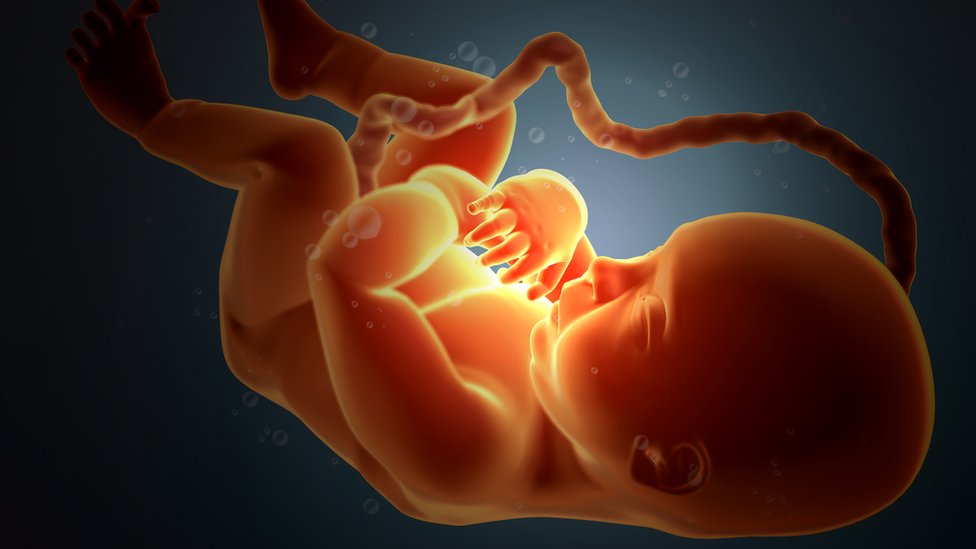 In short, all forces are thrown to the upcoming “publication”. But the most obvious changes in these weeks occur in the lungs – there is an increased maturation of cells that produce surfactant. However, a fetus born during this period can only survive in incubators with artificial lung ventilation, artificial feeding with special infusion media. Therefore, try to keep both him and yourself from rash steps.
In short, all forces are thrown to the upcoming “publication”. But the most obvious changes in these weeks occur in the lungs – there is an increased maturation of cells that produce surfactant. However, a fetus born during this period can only survive in incubators with artificial lung ventilation, artificial feeding with special infusion media. Therefore, try to keep both him and yourself from rash steps.
At this time, it’s time to start preparing for the future feeding of the child. Under the influence of placental lactogen, your breasts, that is, the mammary glands, are growing rapidly. From time to time, droplets of colostrum may appear on the nipples. Daily air baths, washing with cool water, rubbing the nipples with a rough towel will help prepare the nipples for feeding. If the nipples are flat, start to stretch them little by little.
This period completes the second trimester of pregnancy. By this time, the fetus weighs up to 1000 g and has a height of up to 35 cm. However, he still cannot live on his own, because. his lungs are not mature enough and special equipment is still needed to nurse him. During these periods of pregnancy, there is an intensive growth of the fetus, the formation of muscles. His movements become more active. Periods of movement alternate with its relatively calm state when the fetus is sleeping. With an ultrasound, you can see that he already knows how to suck his thumb and even smile!
However, he still cannot live on his own, because. his lungs are not mature enough and special equipment is still needed to nurse him. During these periods of pregnancy, there is an intensive growth of the fetus, the formation of muscles. His movements become more active. Periods of movement alternate with its relatively calm state when the fetus is sleeping. With an ultrasound, you can see that he already knows how to suck his thumb and even smile!
The fundus of the uterus stands on average at a height of 27-28 cm above the womb.
The third trimester of pregnancy begins. The uterus stands at a height of 29-30 cm, it becomes more difficult for you to breathe. Now one of the most serious complications can develop – toxicosis of the second half of pregnancy, which is characterized by the appearance of edema, increased blood pressure and the appearance of protein in the urine. For early diagnosis of this complication, it is necessary to carefully observe an obstetrician-gynecologist and follow all his recommendations, incl.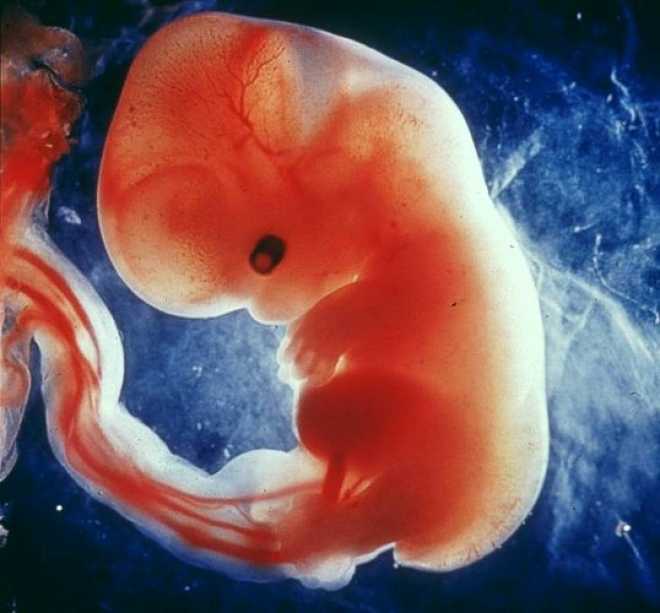 strict weight control. In the III trimester of pregnancy, the daily weight gain should be no more than 50 g, i.e. no more than 300 g per week. You should also monitor the ratio of drunk and secreted fluid.
strict weight control. In the III trimester of pregnancy, the daily weight gain should be no more than 50 g, i.e. no more than 300 g per week. You should also monitor the ratio of drunk and secreted fluid.
Have you asked your doctor how the fetus is? Find out now it’s very important. Its position can be longitudinal, transverse, oblique. Correct, normal is the longitudinal position of the fetus. Childbirth is safer with cephalic presentation. From this period of pregnancy, it is necessary to wear a prenatal bandage that will support the anterior abdominal wall and help maintain the correct position and presentation of the fetus. If the presentation of the fetus is breech, i.e. above the entrance to the pelvis is the pelvic end of the fetus, then the bandage should not be worn yet. There is gymnastics to correct the presentation of the fetus.
In the morning and evening for 1 hour, do the following: lie down on the bed on your left side and lie quietly for 15 minutes, then turn over to your right side and lie for the next 15 minutes, and then repeat these turns 2 more times.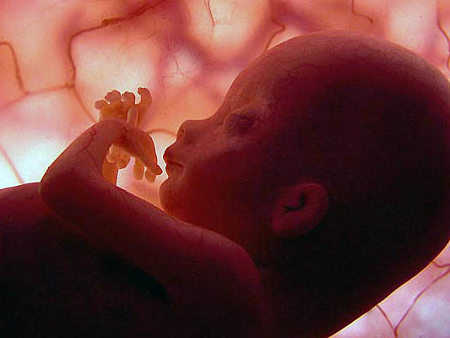
Pregnant women with Rh-negative blood and with O (I) blood type need blood tests for Rh – or group immune antibodies. Immunization of pregnant women with Rh-negative blood is carried out from 28 weeks and within 72 hours after childbirth according to the indications, which will be discussed by the doctor observing you in the antenatal clinic.
The fetus already has a mass of 1800-2100 g, a height of 40-41 cm. By the end of this period, its lungs will begin to produce surfactant in full and will be able to breathe without special equipment. The fetus is fully developed, its chances of surviving in case of preterm birth are greatly increased. However, there is still extremely little subcutaneous fat, so his skin is thin and has a red color. Such a newborn retains heat very poorly and at birth needs an incubator or a heating pad. His body is still covered with fluff and cheese-like grease, the auricles are still very small, but they are already beginning to straighten out, the boy’s testicles descend into the scrotum.
Caring for a premature baby is the hardest work for the whole family, associated with high material costs, physical overload of parents, and this work is not always rewarded, since a child can be born and remain sick. Therefore, up to 37 weeks of pregnancy, a woman should be especially attentive to her condition and, at the slightest suspicion of an increase in the tone of the uterus, starting frequent and regular contractions, immediately consult a doctor.
Doctors know that women, in anticipation of the arrival of a new person in the house, begin to glue walls and paint ceilings during this period. Don’t take unnecessary risks. For this, prenatal leave is provided from 30 weeks, so that you can avoid overwork, do not push in transport, and have the opportunity to sleep. So repairs, stuffy shops, queues are no longer for you.
The fetus already has a mass of 2100-2700 g and a height of 44-45 cm. It is advisable to see a doctor during this period of pregnancy at least once every 10 days.
From this point on, your pregnancy is considered full-term. And if you have a baby in these weeks, he will live. Its development is complete. Now he has a mass of approximately 2700-3000 g. Height is 49-50 cm. The remaining two weeks he will add a little in weight and height.
It becomes easier for you to breathe, as the fetal head is pressed tightly against the entrance to the pelvis, the uterus pulls the anterior abdominal wall more, and therefore its bottom sank lower. Tension of the uterus; small sharp pulling pains in the lumbar region.
With an exacerbation of extragenital diseases, the appearance of signs of toxicosis in the second half of pregnancy, with an incorrect position of the fetus, with some gynecological diseases, against which pregnancy develops, a scar on the uterus, etc., early prenatal hospitalization is required. Do not forget to take an exchange card, passport, medical insurance policy and birth certificate to the hospital.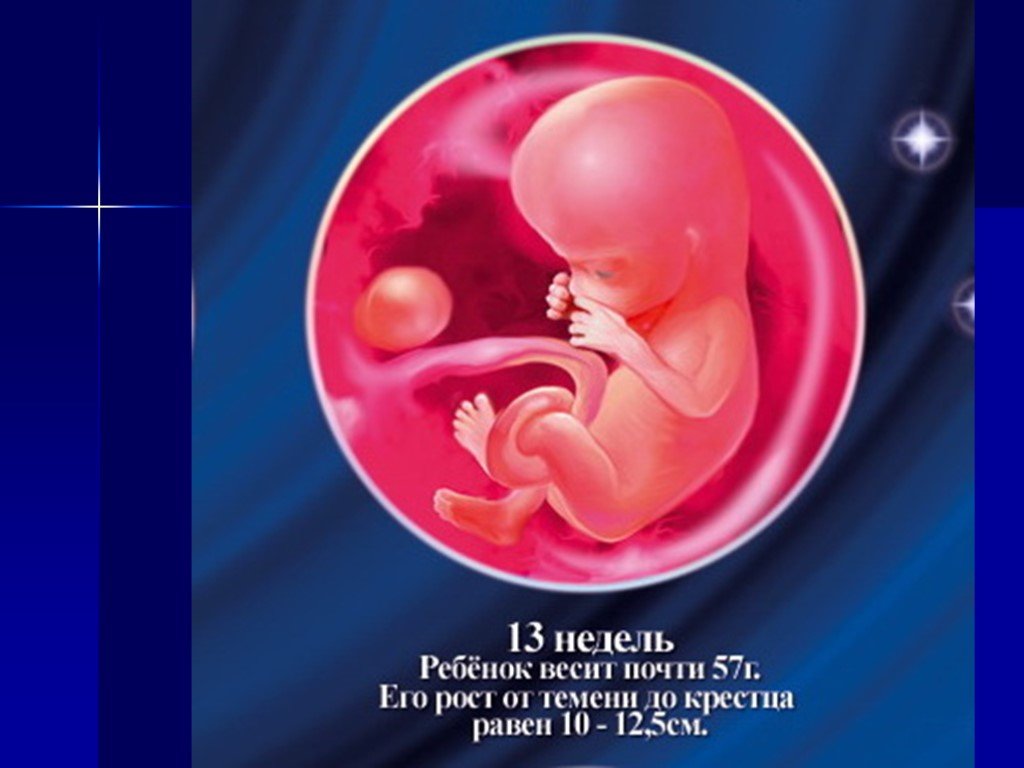
You can find out the approximate day of delivery by the date of the last normal menstruation – count back three months and add 7 days. The resulting number will be the estimated date of birth. More precisely, according to many parameters, ultrasound data, additional studies, the date of the first fetal movement, the date of the first visit to the obstetrician-gynecologist, especially if the visit was before 11-12 weeks of pregnancy.
The child already has all the signs of maturity. His weight is more than 3000 g, and his height is more than 50 cm, he has fair skin, a sufficient amount of subcutaneous fat, he retains heat and does not need special heating. He will scream loudly, breathe, suck. There is a very small amount of lubricant on the skin, which will no longer be able to protect it from the effects of amniotic fluid.
For you, regular contractions (1 contraction every 10 minutes) will become an indicator of the beginning of the birth process, or you will feel the outflow of amniotic fluid, you will see scanty bloody discharge – do not panic, call an ambulance, the telephone number for transportation for pregnant women is written on the margins of your exchange card.